What is A/B testing?
To put in broad terms, A/B testing is used in online marketing to see how different audiences react to variations of a product and measure its performance. This method isn’t new; in fact, its uses are over 100 years old. It is only in the past couple of decades that it has been used to optimize online products and advertising. A/B testing isn’t a one-trick pony used to tell companies what they’re doing wrong; it should be used as a scientific method to gather data on what variables will increase their performance metrics. For example, if your company depends on monthly paid subscribers to stay in business, you might want to perform an A/B test to see what variables will increase the number of free subscribers switching to a paid subscription.
In reality, there are different reasons to why someone does not switch to a paid subscription service; they are unaware of the service, the price is too high, the benefits aren’t exactly clear, and etc. A/B testing provides a method to test which of these reasons are affecting your numbers and by how much. You could test to see whether the location or the size of the subscription button on your website will increase rates, alternating between a large and a small button above and below the main page. Performing regular A/B tests is important for understanding how your market reacts to your product and allows you to capitalize on data in order to meet your company goals.
How you can use A/B testing for your next project

All websites have a goal or a reason to exist, such as attracting visitors to purchase products, sign up for paid subscription or services, or click on advertisements. A/B testing can be used by any company to reach their targeted goal. For example, a company will test sending out different emails of various lengths to their subscribers to see which is the most effective. They can then see which emails will convert visitors to their website to purchase their products. This ensures that the data collected can be used going forward in their marketing plan where short emails with more images produce more sales.
Likewise, A/B testing provides real quantitative data and insight on the behaviours of your audience. You can test how effective colours are on certain demographics or if links work better at the beginning of emails compared to the end. There are hundreds of variables to test so make sure you are considering the most effective ones relative to your goals. This provides invaluable data that will allow you to understand your audience, adjust your work accordingly, and provide successful results that will bring you one step closer to your goals. Although the uses of A/B testing are broad and applicable to
What to consider for an A/B test
In order to set up an A/B test, you should treat it as you would any other experiment. Remember to test your variables and make the test reflect an outcome to your hypothesis.
- Identify the issue or goal. What do you want to fix or achieve? This depends on your company – whether you want more sign-ups on your website or you find an unusually low open rate for your emails. It’s important to be clear on what you are looking to improve.
- Create a hypothesis. Consider your product and find where the issue stems from or where the goal fails to convert. For example, maybe your sign-up button is hard to find on your website and that results in a loss of subscribers.
- Test your hypothesis. Generally, you want to stick to one variable per test. You can add more variables to your test but ensure you have appropriate control groups to ensure accurate data. Run it for a predefined amount of time and to a small sample of your target audience. If you put too many variables in one test you won’t know what variable was effective!
- Analyze your data. This is essential to know what works and what doesn’t. Your analytics team should ensure that your test is set up to provide results that are clear and understandable. For more information on how to get a good analyst, read our article here Blog 2: What’s the difference between good and bad analysts.
- Conclusion and integration. Draw conclusions from your test. Maybe your sign-up button simply needs to be larger because you cater to an older demographic. Let the rest of your teams know so they can use this data to optimize other aspects of the campaign.
Here are some variables to consider for your next A/B test, taken from Digital Marketing Magazine:
- Subject titles and subtitles
- Product descriptions
- Text (length, style)
- Offers
- Price
- Images
- Call to action button (text, colour, position)
- Colour schemes
- Forms (length, question)
- Page layouts
How A/B testing will help improve your bottom line

The point of A/B testing is to ensure the maximum effectiveness of your product by obtaining information on how and why your consumers interact with your product under measurable conditions. While getting traffic to your website can be expensive and difficult, the cost of optimizing your conversion rates are minimal in comparison.
A/B testing can be a constant process in order to consistently measure the most effective way to market to your audience. This way, you are gaining the most up-to-date and relevant information on your audience. Performing regular A/B tests can help you identify and capitalize on opportunities in your market. After all, there’s a science to marketing.

















